
I must preface this with: I am not a cheesecake person. At all.
I know. I’m strange.
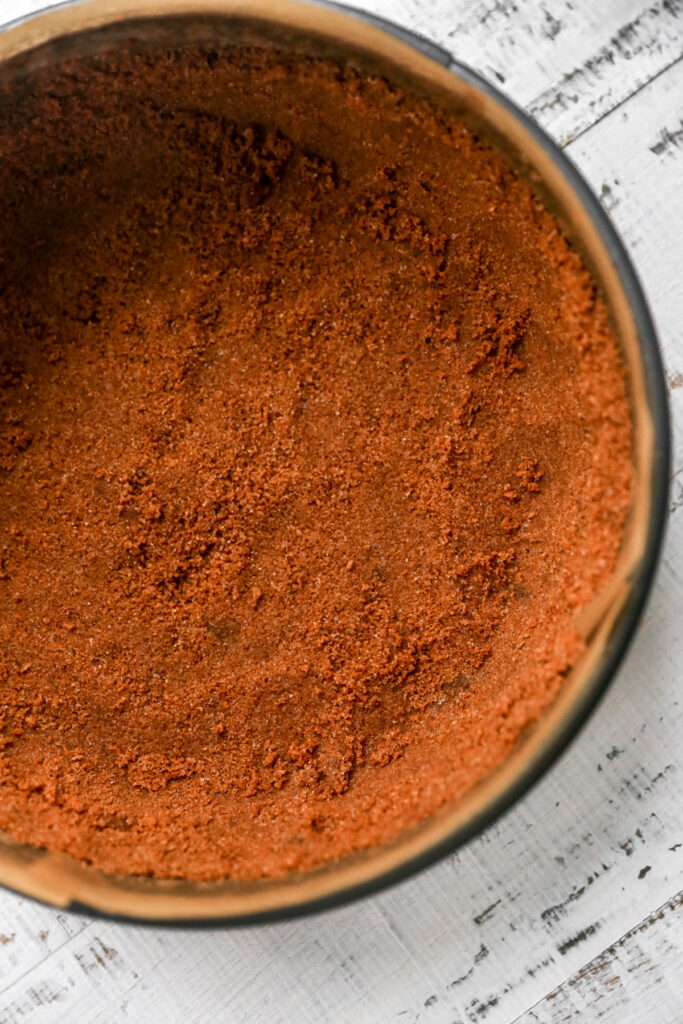
While I can appreciate cheesecake for what it is, it is never my dessert of choice. I do not crave it. I would pick a lot of other things before cheesecake.
Until now.
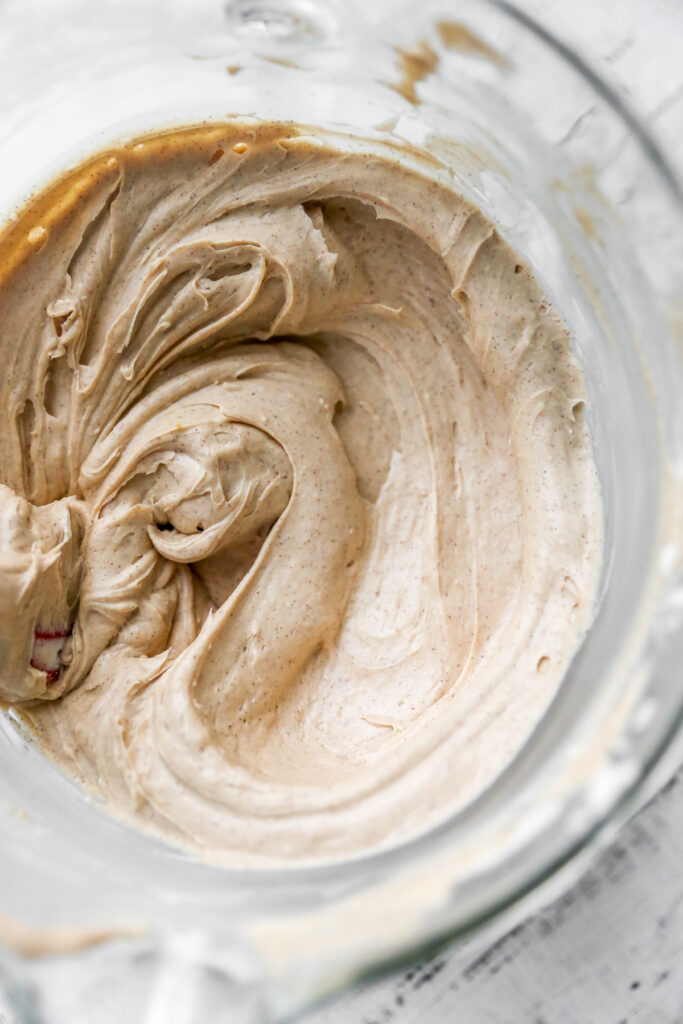
This Snickerdoodle Biscoff Cheesecake blew me away. It is creamy and dense, sweet and tangy, and features two of my favorite flavors: Biscoff cookie butter and snickerdoodles! It is to die for.

When I first decided I was going to attempt cheesecake, I knew I had to do some serious research and trial-and-error testing. I have made a handful of cheesecakes in my life, and I wanted this one to be perfect. It took a couple trials (and copious amounts of cream cheese), but I got it right. This cheesecake really is perfection.
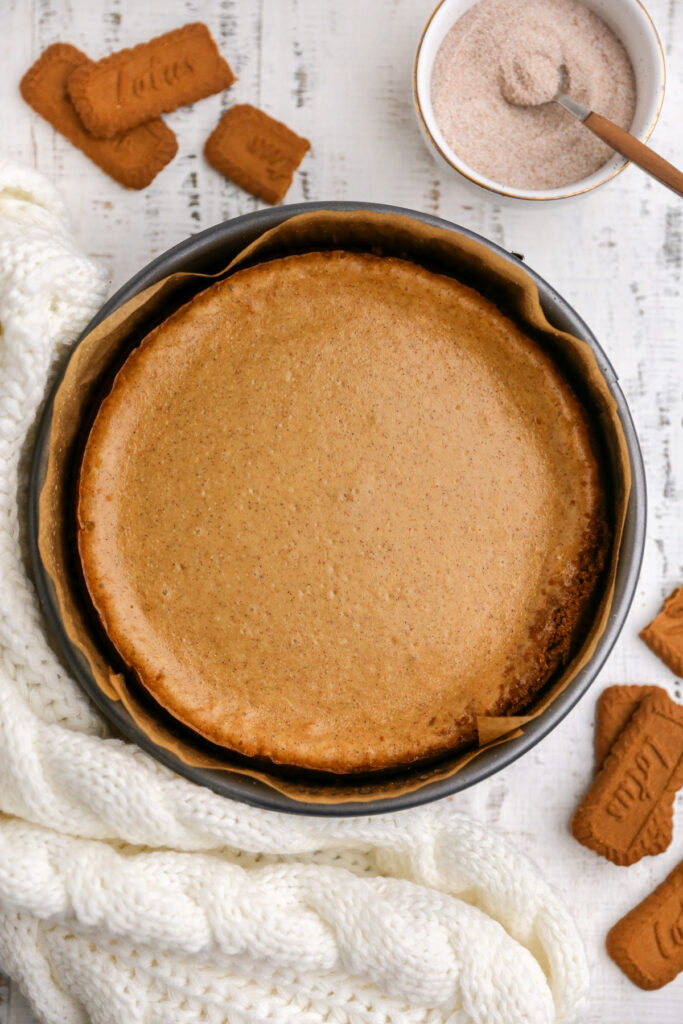
It has a Biscoff cookie crust, a filling flavored with Biscoff cookie butter and cinnamon sugar, and it gets topped with cinnamon sugar after it has baked and chilled – to really emulate the experience of biting into a snickerdoodle cookie. Then, just before serving, it gets drizzled with warmed cookie butter. It is INCREDIBLE.
Warm, cozy flavors in cheesecake form!
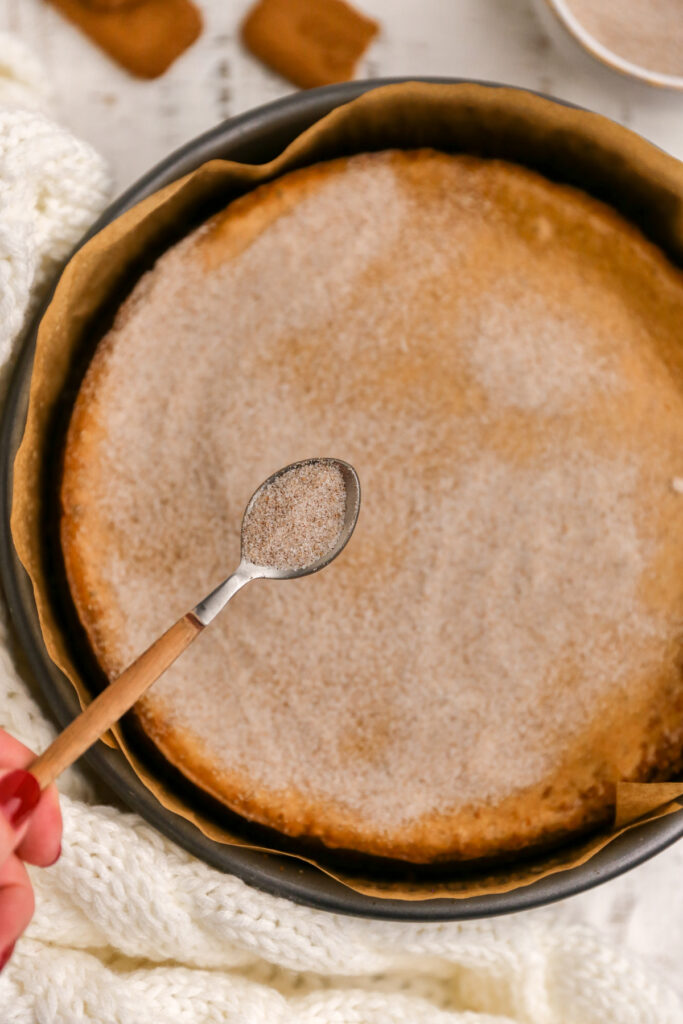
My husband and non-cheesecake-loving self couldn’t stop eating this straight out of the fridge for days afterwards. He finally asked me to get rid of it because he couldn’t stop eating it and he was starting to feel it in his waistline. Hah! It’s addicting!
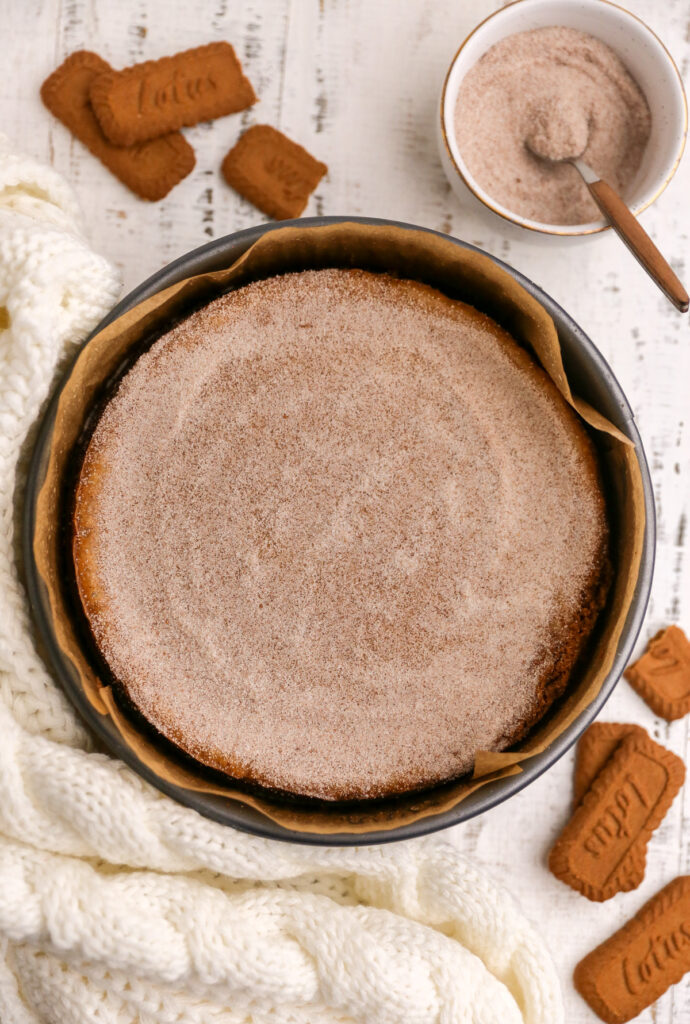
Let’s get into how to make this incredible Snickerdoodle Biscoff Cheesecake.
Ingredients You’ll Need for this Snickerdoodle Biscoff Cheesecake:
- Biscoff cookies
- Melted butter
- Cream cheese
- Sugar
- Biscoff cookie butter
- Vanilla bean paste or extract
- Cinnamon
- Kosher salt
- Sour cream
- Eggs

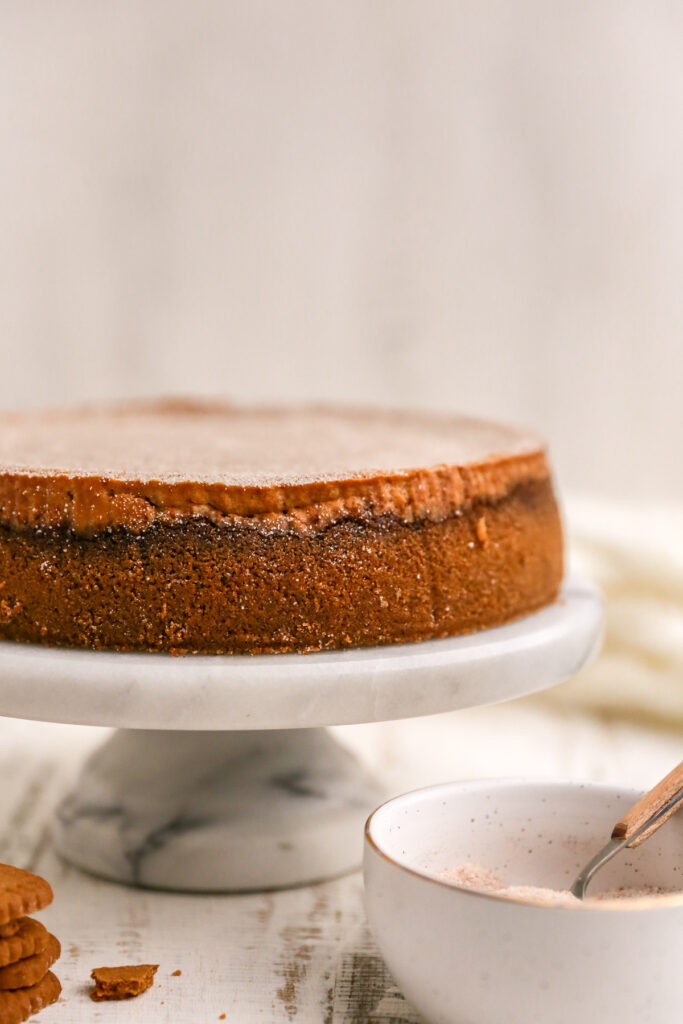
How to Make this Snickerdoodle Biscoff Cheesecake:
- Start by making your crust. Pulse the Biscoff cookies, sugar, salt, cinnamon, and melted butter in a food processor until small, moist crumbs form. Press the mixture into a springform pan that’s been lined with parchment paper and liberally greased.
- Bake the crust.
- While the crust bakes, make the filling by beating together the cream cheese, sugar, cookie butter, vanilla, cinnamon, salt, and sour cream until smooth and creamy. Take the time to stir the mixture with a spatula a few times throughout the mixing process, so excess air is not incorporated (too much air in the batter can cause a cheesecake to crack).
- Beat in the eggs one at a time, again mixing until creamy and smooth.
- Pour the filling into the baked crust.
- Place a large baking dish on the bottom rack of your oven and carefully fill with boiling water.
- Place the cheesecake on the rack above the pan with water.
- Bake for 1 hour and 15 minutes (begin checking at the 1-hour mark), or until the cheesecake is completely firm and puffed around the edges and only has a slight jiggle in the center when you gently shake the pan.
- Turn off the oven, crack the oven door, and allow the cheesecake to sit in the oven for 1 hour.
- Remove the cheesecake from the oven and cool it to room temperature, about 1 hour.
- Transfer the cheesecake to the fridge to chill for at least 4 hour (overnight is best).
- Before serving, sprinkle the top of the cheesecake with cinnamon sugar. Slice and serve, drizzled with warmed cookie butter.


Tips for Making the Best Cheesecake:
- Use full-fat dairy ingredients. Cheesecake is not meant to be a light dessert. We need the fat in the sour cream and cream cheese to ensure the correct creamy and dense texture of the cheesecake.
- Ensure your ingredients are at room temperature. This is imperative for achieving a smooth and creamy cheesecake filling. It is incredibly hard to get it to mix properly unless everything is at room temperature.
- Line the bottom and sides of your pan with parchment paper that has been liberally greased. When cheesecakes bake, they expand. When they cool, they shrink. When the contact with the pan is reduced, there is less chance that the cheesecake will stick to the sides of the pan, which helps ensure that it will shrink without resistance as it cools. You are less likely to have your cheesecake crack if you take this step.
- Take the time to remove excess air from the filling before it goes in the oven. Scrape down the sides of your bowl and thoroughly stir through the filling mixture with a spatula to remove excess air. Rap your pan a few times on the counter before putting it in the oven. This also helps to remove excess air, and thus, helps prevent your cheesecake from cracking.
- A gradual cooling process is imperative for your cheesecake not cracking. When the temperature drops too drastically, the cheesecake will shrink too rapidly and crack. Allowing the cheesecake to sit in the hot oven after baking, then sit at room temperature, and THEN chill in the fridge will ensure that it will not crack.
- Allow for adequate chilling time. In my opinion, it is best to make cheesecakes the day before you want to serve them. They take a long time to bake and cool down, and the texture is best after it has chilled in the fridge for many hours. I prefer at least 8 hours but overnight is best.
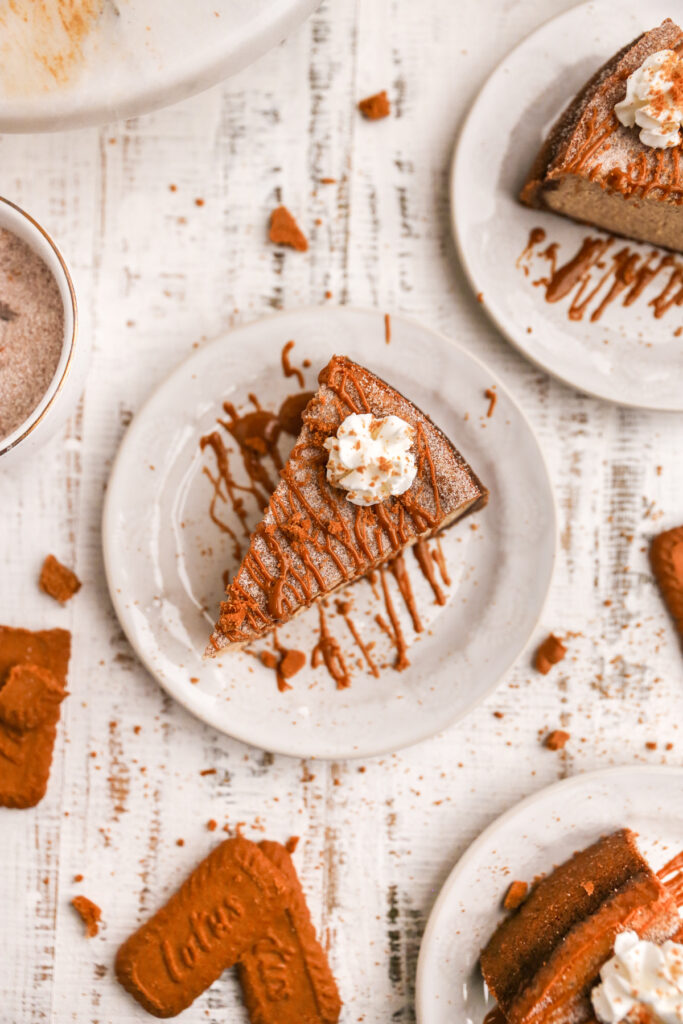
I can’t get over how well this cheesecake turned out. We were floored at it’s texture and flavor, and I could seriously eat it any day of the week. THAT’S how good it is. Again, I am NOT a cheesecake person. Who am I?!

This Snickerdoodle Biscoff Cheesecake would make for a stunner centerpiece of your holiday dessert table. People will flip.
It will certainly be on ours!
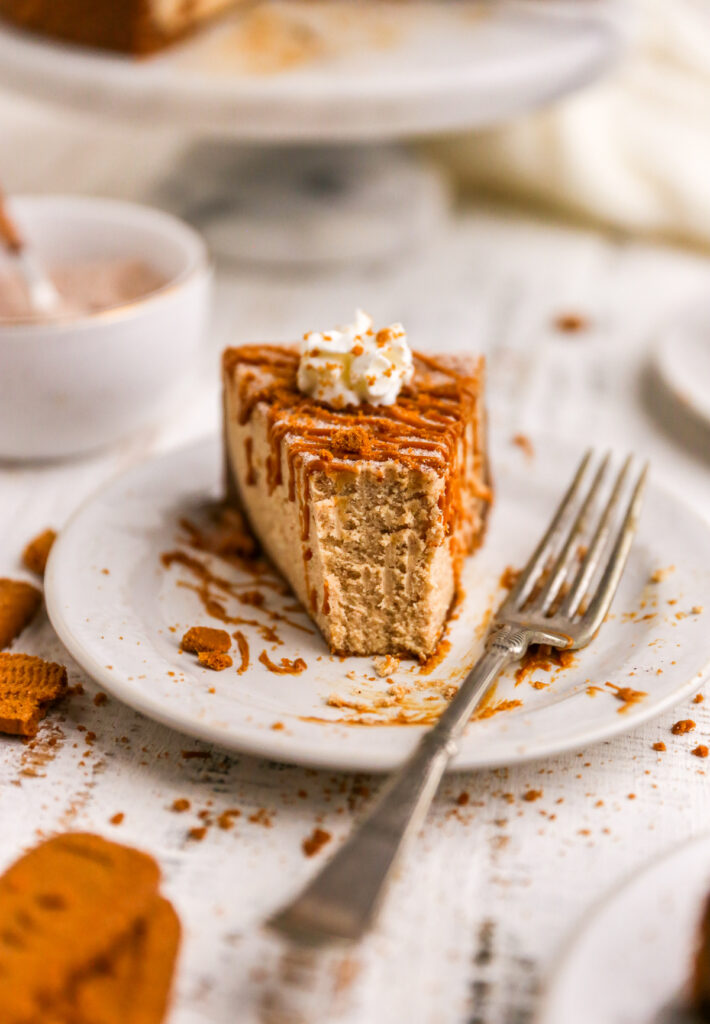
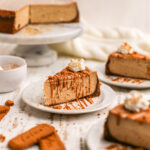
Snickerdoodle Biscoff Cheesecake
- Total Time: 2 hours
- Yield: 12 servings 1x
Description
This Snickerdoodle Biscoff Cheesecake is an incredible combination of flavors and textures! Sweet and tangy, amazingly creamy, a Biscoff cookie crust, and a filling flavored with Biscoff cookie butter and cinnamon sugar. A sprinkling of cinnamon sugar on top before serving drives home that snickerdoodle experience! This is a stunner of a dessert.
Ingredients
For the Crust:
- 2 cups Biscoff cookie crumbs (roughly 30 cookies)
- 1 teaspoon ground cinnamon
- 1/4 cup sugar
- 1/2 teaspoon kosher salt
- 6 tablespoons unsalted butter, melted
For the Filling:
- 4 (8-oz) blocks of full-fat cream cheese, softened to room temperature
- 1/2 cup Biscoff cookie butter
- 1 cup granulated sugar
- 1/2 cup full-fat sour cream, at room temperature
- 2 teaspoons vanilla bean paste or extract
- 2 teaspoons ground cinnamon
- 4 large eggs, at room temperature
For Serving:
- 1/4 cup cinnamon sugar (1/4 cup granulated sugar + 1 teaspoon ground cinnamon)
- Warmed cookie butter
- Crushed Biscoff cookies
- Whipped cream
Instructions
For the Crust:
- Preheat the oven to 350°F.
- Place roughly 30 Biscoff cookies in the bowl of a food processor. Pulse the machine until fine crumbs form.
- Add in the cinnamon, sugar, and salt and pulse to combine.
- With the machine running, slowly stream in the melted butter. Run until all the crumbs are moistened by the butter and beginning to clump together.
- Generously spray a 9-inch springform pan with nonstick cooking spray on the bottom and sides. Line the bottom and sides of the pan with parchment paper (I do one round piece for the bottom and a thin strip that runs around the sides). Spray the parchment paper with nonstick cooking spray.
- Press the cookie crumb mixture into the pan, firmly packing it to form the crust. It should fully cover the bottom of the pan and up a couple inches on the sides of the pan.
- Bake the crust for 10 minutes.
- Remove from the oven and allow to cool while you finish prepping the rest of the cheesecake.
For the FIlling:
- Set a kettle or pot of water on to boil.
- While the crust is baking, make the filling by combining the blocks of cream cheese in a stand mixer (alternatively, you can mix it in a bowl with a hand mixer). Beat the cream cheese together until smooth and creamy. It’s important to thoroughly cream the cream cheese before adding the other ingredients – it makes for a silky smooth filling.
- After the cream cheese is smooth, stir it with a spatula to remove any excess air that may have been incorporated. Excess air can cause your cheesecake to crack during baking.
- Beat in the cookie butter, sugar, sour cream, vanilla, and cinnamon until smooth. Again, scrape down the sides and stir the mixture with a spatula to remove excess air.
- Add the eggs, one at a time, and beat after each addition until the filling is smooth and creamy.
- Take your spatula and once again stir the batter a few times, taking out any excess air that may have been incorporated.
Baking the Cheesecake:
- Reduce the oven temperature to 325°F and place a large baking dish on the bottom rack of the oven. Carefully pour the boiling water (I find that using a kettle for this is easiest) into the baking dish and close the oven door.
- Pour the cheesecake filling into the crust and smooth out the top. Rap the pan gently on the counter a few times to remove any air bubbles in the filling.
- Transfer the cheesecake to the oven, setting it on the middle rack above the baking dish with water, and close the door quickly so that all the moisture does not escape.
- Bake for 1 hour 15 minutes or until the cheesecake is puffed and set around the edges and has a slight jiggle in the center when you shake the pan. Start checking it around 1 hour (all ovens are different and actual cooking time may vary a bit).
- Turn off the oven and crack open the oven door. Allow the cheesecake to sit in the oven with the door open for 1 hour.
- After 1 hour, remove the cheesecake from the oven and allow it to cool to room temperature.
- Once it is cool, transfer the cheesecake to the fridge for a minimum of 4 hours (longer is actually better – I prefer to do it overnight).
To Serve:
- Remove the cheesecake from the fridge and gently and carefully remove the collar from the springform pan. Peel off any parchment paper that may be sticking to the cheesecake.
- Sprinkle the top of the cheesecake all over with the cinnamon sugar.
- Warm the cookie butter up in the microwave and then drizzle as much or as little of it as you would like over top of the cheesecake (alternatively, you can drizzle it over individual slices of cheesecake)..
- Slice with a very sharp knife and serve, garnished with whipped cream and additional crushed Biscoff cookies, as preferred.
Notes
- While Biscoff cookies are recommended here, you could use graham crackers instead.
- Using full-fat dairy and room temperature ingredients will ensure that your filling mixes together easily and smoothly – this results in a creamy cheesecake.
- All the steps outlined in the baking section are important. Gradually cooling the cheesecake down with these steps helps prevent the cheesecake from cracking. We don’t want the filling to seize from the drastic drop in temperature. Doing so gradually makes a big difference.
- Leftover cheesecake will keep in the fridge for up to a week. I also have frozen individual slices with great results.
- Prep Time: 30 minutes
- Cook Time: 1 hour 30 minutes (plus chill time)
- Category: cheesecake
Keywords: Snickerdoodle Biscoff Cheesecake, snickerdoodle cheesecake, biscoff cheesecake, cookie butter cheesecake, the best biscoff cheesecake

Wow wow wow!! I made this for Friendsgiving this past weekend and it stole the show. Everyone loved it – might be the best cheesecake I’ve ever had. Recipe and instructions were perfection!
★★★★★